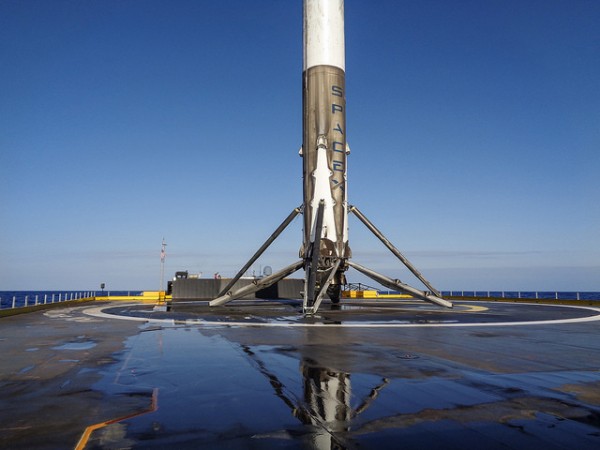By Ana Verayo, | May 07, 2016

JCSAT-14 first stage on droneship
On Friday, SpaceX landed its new Falcon 9 rocket on a droneship off the coast of Florida, making this the second successful attempt for a vertical rocket landing at sea and the third successful attempt for an overall use of a reusable rocket.
Like Us on Facebook
During a live broadcast, the first stage of the booster rocket landed in an upright position during the wee hours of the morning on a floating robotic barge. Just last April 8, SpaceX has proven that landing a rocket is possible during a cargo resupply mission for NASA. This first landing at sea also provides a glimpse of the future of reusable, unmanned rockets, to slash expensive space launch costs.
This mission apparently required a much higher altitude than the previous ones, as CEO and founder Elon Musk initially did not expect a successful landing, as the commentator declared that the Falcon has landed. Musk was more ecstatic, exclaiming "Woohoo!!" on Twitter, adding the need to increase the size of the rocket hangar.
The rocket arrived at a faster rate and hotter temperatures than the previous flight, adding that, after the three engine burn upon the booster's return, the deceleration tripled since the last flight. Musk even predicted that the chances were even, before the launch from Cape Canaveral.
To date, SpaceX is the only private space company to launch and recover a rocket from a re-entry from lower Earth orbit. Last December marked the first time that the Falcon 9 booster landed on the ground at Cape Canaveral Air Force Station however, it took about several failures and explosions to land the rocket at sea.
Musk already announced of his plans re-flying last month's booster, which could happen as soon as June. The first recovered SpaceX booster from December will now be housed in the headquarters of SpaceX in Hawthorne, California.
SpaceX is already under a multi million dollar contract with NASA for cargo resupply missions to the International Space Station, however, the main goal next year is to deliver astronauts to the orbiting space laboratory as early as next year and after that, to Mars, via its Dragon capsules.
Last week, Musk announced that SpaceX plans to send humans to Mars as early as 2018 via the Red Dragon. Musk is envisioning for SpaceX to land the first humans on the surface of the Red Planet and colonize it.
Friday's mission involved travelling twice as fast than last month's launch, delivering into orbit a television broadcast satellite some 20,000 mies farther than the International Space Station, which is 250 miles above Earth. The Falcon 9 rocket blasted off around 1:21 A.M. EDT from a seaside launchpad at Canaveral Florida, carrying a Japanese JCSAT-14 satellite owned by Sky Perfect JSAT Corp.
-
Use of Coronavirus Pandemic Drones Raises Privacy Concerns: Drones Spread Fear, Local Officials Say

-
Coronavirus Hampers The Delivery Of Lockheed Martin F-35 Stealth Fighters For 2020

-
Instagram Speeds Up Plans to Add Account Memorialization Feature Due to COVID-19 Deaths

-
NASA: Perseverance Plans to Bring 'Mars Rock' to Earth in 2031

-
600 Dead And 3,000 In The Hospital as Iranians Believed Drinking High-Concentrations of Alcohol Can Cure The Coronavirus

-
600 Dead And 3,000 In The Hospital as Iranians Believed Drinking High-Concentrations of Alcohol Can Cure The Coronavirus

-
COVID-19: Doctors, Nurses Use Virtual Reality to Learn New Skills in Treating Coronavirus Patients







